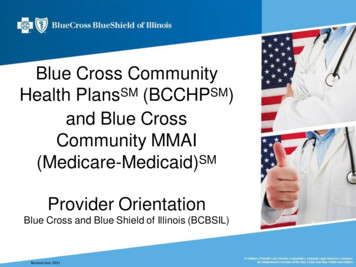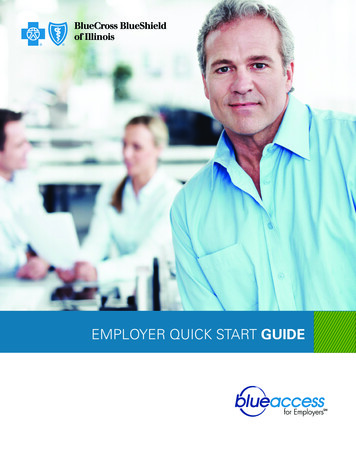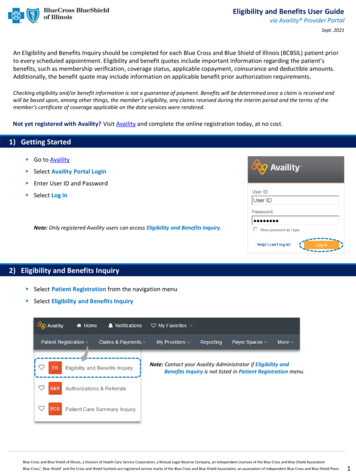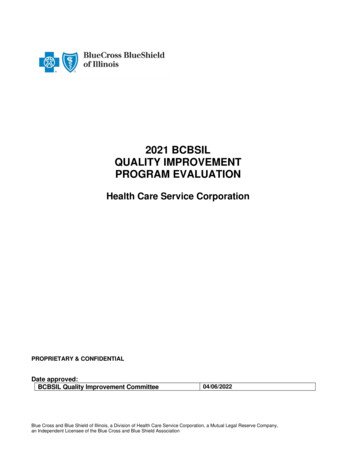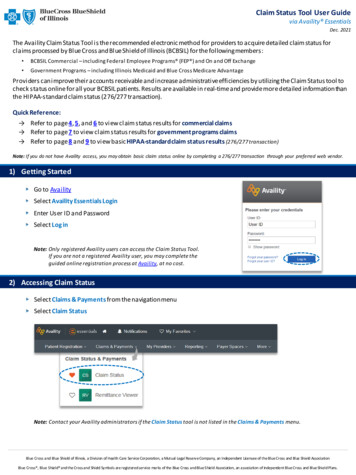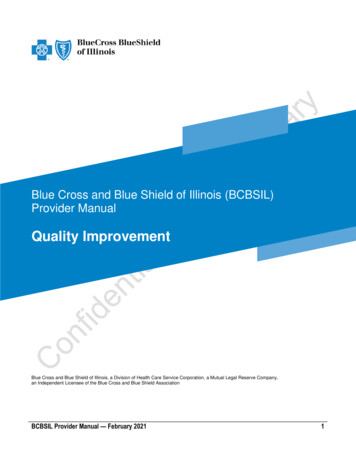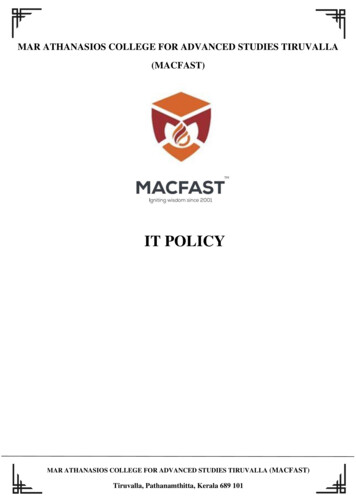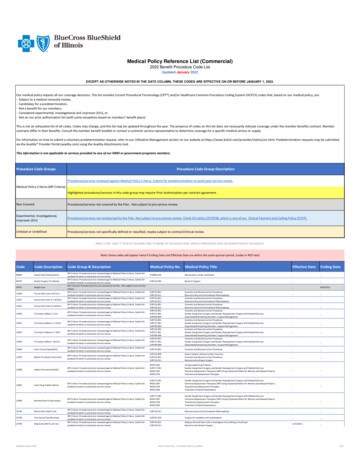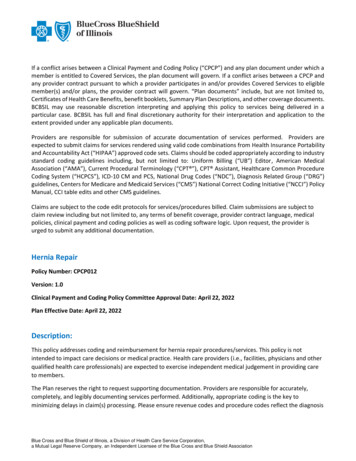
Transcription
If a conflict arises between a Clinical Payment and Coding Policy (“CPCP”) and any plan document under which amember is entitled to Covered Services, the plan document will govern. If a conflict arises between a CPCP andany provider contract pursuant to which a provider participates in and/or provides Covered Services to eligiblemember(s) and/or plans, the provider contract will govern. “Plan documents” include, but are not limited to,Certificates of Health Care Benefits, benefit booklets, Summary Plan Descriptions, and other coverage documents.BCBSIL may use reasonable discretion interpreting and applying this policy to services being delivered in aparticular case. BCBSIL has full and final discretionary authority for their interpretation and application to theextent provided under any applicable plan documents.Providers are responsible for submission of accurate documentation of services performed. Providers areexpected to submit claims for services rendered using valid code combinations from Health Insurance Portabilityand Accountability Act (“HIPAA”) approved code sets. Claims should be coded appropriately according to industrystandard coding guidelines including, but not limited to: Uniform Billing (“UB”) Editor, American MedicalAssociation (“AMA”), Current Procedural Terminology (“CPT ”), CPT Assistant, Healthcare Common ProcedureCoding System (“HCPCS”), ICD-10 CM and PCS, National Drug Codes (“NDC”), Diagnosis Related Group (“DRG”)guidelines, Centers for Medicare and Medicaid Services (“CMS”) National Correct Coding Initiative (“NCCI”) PolicyManual, CCI table edits and other CMS guidelines.Claims are subject to the code edit protocols for services/procedures billed. Claim submissions are subject toclaim review including but not limited to, any terms of benefit coverage, provider contract language, medicalpolicies, clinical payment and coding policies as well as coding software logic. Upon request, the provider isurged to submit any additional documentation.Hernia RepairPolicy Number: CPCP012Version: 1.0Clinical Payment and Coding Policy Committee Approval Date: April 22, 2022Plan Effective Date: April 22, 2022Description:This policy addresses coding and reimbursement for hernia repair procedures/services. This policy is notintended to impact care decisions or medical practice. Health care providers (i.e., facilities, physicians and otherqualified health care professionals) are expected to exercise independent medical judgement in providing careto members.The Plan reserves the right to request supporting documentation. Providers are responsible for accurately,completely, and legibly documenting services performed. Additionally, appropriate coding is the key tominimizing delays in claim(s) processing. Please ensure revenue codes and procedure codes reflect the diagnosisBlue Cross and Blue Shield of Illinois, a Division of Health Care Service Corporation,a Mutual Legal Reserve Company, an Independent Licensee of the Blue Cross and Blue Shield Association
and services rendered. Claims that do not adhere to coding and billing guidelines may result in a denial orreassigned payment rate. Claims may be reviewed on a case-by-case basis.A hernia can occur when an internal organ or another part of the body protrudes through the wall of the cavitythat it is normally enclosed in. When muscles become weak, tissue can bulge through an opening and can causea visible lump that may or may not be associated with pain. Hernia repair is a method of treatment for somehernia types.Reimbursement Information:The following is informational and is not an all-encompassing coding list. The inclusion of a code below does notguarantee a covered service or eligible reimbursement.Hernia TypeTypes of HerniaTypeDescriptionDiagnosisCause &SymptomsCodesDiaphragmaticHernia BochdalekHernia- Back andside of thediaphragm. Theintestines, liver,stomach and/orspleen moveupwards into thechest cavity.For infants, abirth defect inwhich there isan abnormalopening in thediaphragm.For infants:Ultrasound offetus beforebirth; Afterbirth-physicalexam, X-ray,ultrasound, CTScan, MRI,arterial bloodgas testCommoncauses:CongenitalDiaphragmaticHernia (CDH)from abnormalabdominalfetaldevelopment,or injuries tothe 1,39599,44238 MorgagniHernia- Frontside of thediaphragm. Theintestines and/orliver moveupwards into thechest cavity.In rareinstancesthere can belate onset ordiagnosis ofdiaphragmatichernias thatmay berelated to atrauma orother cause.For adults:Ultrasound, Xray, CT Scan,MRI (Imagingstudies)Symptomsmay include:Difficultybreathing,rapid inalpain,indigestion, orabnormalchestdevelopment.2
EpigastricHernia IncarceratedHernia- herniathat is trapped inthe abdominalwall. StrangulatedHernia- Anincarceratedhernia thatbecomesstrangulatedcutting off theblood flow.Symptoms of thisinclude nausea,high fever, sharppains andswelling.FemoralHernia IncarceratedHernia- herniathat is trapped inthe abdominalwall. StrangulatedHernia- Anincarceratedhernia thatbecomesstrangulatedcutting off theblood flow.Symptoms of thisinclude nausea,high fever, sharppain andswelling.Hiatal Hernia Sliding HiatalHernia- Commonhiatal hernia thatoccurs whengastroesophagealjunction and partof the stomachSmall in size, 5cm to 6 cm.TypicallyAbove theumbilicus inthe upperabdomenPhysical exam,ultrasound, CTScan.Commoncauses: Aging,injury, heavylifting,persistentcoughing,difficulty withbowelmovements orurination thatcauses theabdominal wallto weaken orseparate.49570,49572,49652,49653Symptoms caninclude: Bulgein upperabdomen, orsharp pain.Uncommonhernia thatappears as apainful lumpin the innerupper part ofthe thigh orgroin that canoften bepushed backinPhysical exam,ultrasoundCommoncauses: fattytissue or partof bowel pokesthrough intogroin at top ofinner thigh;strain onabdomen;weak femoralcanal.49550,49553,49555,49557Protrusion ofthe upper partof thestomach intothe thoraxthrough a tearor weakness inUpper GIEndoscopy,BariumSwallowStudy, MRI orCT ScanCommoncause 2,43333,43334,Symptoms caninclude: Acidreflux, chronicheartburn,GERD,3
protrude into thechest.thediaphragm. Para-esophagealHernia- When aportion of thestomachprotrudesthrough the holethat theesophaguspasses throughto thediaphragm.IncisionalHernia IncarceratedHernia- herniathat is trapped inthe abdominalwall. StrangulatedHernia- Anincarceratedhernia thatbecomesstrangulatedcutting off theblood flow.Symptoms of thisinclude nausea,high fever, sharppain andswelling.InguinalHernia IncarceratedHernia- herniathat is trapped inthe abdominalwall. StrangulatedHernia- Anincarceratedhernia thatbecomesstrangulatedcutting off theblood flow.Symptoms of thisOccurs at thearea of a prioroperation dueto aweakening ofthe abdominalwall.Physical exam,blood tests, Xray or CT Scan.difficultyswallowing, orrestrictedblood flow tothe nancy,excessivepressure fromcoughing orsneezing, orheavy 49654,49655,49656,49657Symptoms caninclude Fever,infection,bulging, visualprotrusion,pain, ache, orswelling.Occurs whentissueprotrudesthrough aweak spot inthe abdominalmuscles/groinarea.Physical exam,ultrasound, CTScan or MRI.Commoncauses:Increasedpressure w/inthe abdomen,pregnancy,chroniccoughing orsneezing, orstrenuousactivity.Symptoms 501,49505,49507,49520,49521,49525,49650,49651,4
include nausea,high fever, sharppain andswelling.SpigelianHernia IncarceratedHernia- herniathat is trapped inthe abdominalwall. StrangulatedHernia- Anincarceratedhernia thatbecomesstrangulatedcutting off theblood flow.Symptoms of thisinclude nausea,high fever, sharppain andswelling.UmbilicalHernia IncarceratedHernia- herniathat is trapped inthe abdominalwall. StrangulatedHernia- Anincarceratedhernia thatbecomesstrangulatedcutting off theblood flow.Symptoms of thisinclude nausea,high fever, sharppain andswelling.Ventral Hernia Strangulatedventral hernia-Herniathrough theSpigelianfascia, defectin the lateralabdominalwall. This isalso called alateral ventralhernia. (At avery high riskforstrangulation.)Physical exam,ultrasound, CTScan, X-rayOccurs whenpart of theintestineprotrudesthrough theumbilicalopening in theabdominalmuscles.Physical exam;forcomplications,an abdominalultrasound orCT Scan.muscleweakness,sharp pain,swelling inscrotum, orbulge in groin.54640,55540Commoncauses:Weaknesses inthe muscles ofthe abdomen,previousinjury, heavylifting, chroniccoughing.49590,49652,49653Symptomsmay include:Pain increasingwith activities,strainingduring bowelmovements,heavy lifting,nausea, orvomiting.Commoncauses ForInfants:Prematurebabies w/lowbirth weight;For Adultsobesity 7,49652,49653,51500Symptomsmay include:Swollen bulgenear navel.Bulge oftissuesPhysical exam,abdominalCommoncauses:49560,49561,5
the intestinaltissue is firmlycaught withinthe opening ofthe abdominalwall andcannot bepushed back.Blood flow iscut offrequiringsurgeryimmediately.through aweaknesswithin theabdominalwall muscles.ultrasound,abdominal CTScan,abdominalMRI Scan.pregnancy,obesity,history ofprevioushernias,previoussurgeries,family history,frequent liftingof heavyobjects, orinjuries 49656,49657Symptoms caninclude: Milddiscomfort inabdominalarea, pain,bulging of skinor tissues,nausea, orvomiting.Note: Unlisted laparoscopic procedures including, hernioplasty, herniorrhaphy and herniotomy, may bereimbursed when using CPT code 49659, for a laparoscopic repair. Hybrid laparoscopic and open repairs during ahernia repair procedure should include the applicable code for the open hernia repair.For a complete list of the General Treatment Course see MCG care guidelines and other industry standardguidelines.Preoperative TestingPreoperative testing before a low-risk surgery, for members needing a hernia repair procedure withoutcomorbidities, may not be necessary. The physician is urged to follow the most current best practice guidelinesfor preoperative testing.Preoperative testing that is performed at the facility related to hernia repair procedures should be included inthe same claim submission as the procedure regardless if the testing was done on the same date. If the testing isdone outside of the facility prior to admission, it should be billed separately. All preoperative testing should becompleted within 24 to 72 hours of admission unless otherwise agreed upon.Bariatric Surgery Billed with Hernia RepairProviders should check the member’s benefit coverage and/or exclusions for bariatric surgery and complicationsrelated to bariatric surgery. Hiatal hernia repair codes may be considered incidental or mutually exclusive if6
billed on the same date of service with the following bariatric codes, including, but not limited to: 43999, 43659,43770, 43771, 43772, 43773, 43774, and 43775.Additional Information If the clinical documentation does not support the medical necessity of a hernia repair, hernia repaircodes will be denied. Services associated with the above-mentioned procedures such as devices, procedures, suppliesand/or drugs may also be considered not medically necessary or experimental, investigational and/orunproven (EIU). Additionally, services considered to be related to a non-covered service may also beconsidered non-covered. Related services include but are not limited to those services that areperformed or utilized in conjunction with surgical procedures, infusion/administration of drugs,performance of tests, etc. Exclusions may apply under benefit plans or other plan documents.References:CPT copyright 2021 American Medical Association (AMA). All rights reserved. CPT is a registered trademark ofthe AMA.CPCPLAB012 Pre-Operative TestingPolicy Update History:Approval 2022DescriptionNew PolicyAnnual reviewAnnual review, Updated Disclaimer, References, Policy languageAnnual ReviewAnnual Review7
sharp pain. 49570, 49572, 49652, 49653 Femoral Hernia Hernia Incarcerated - hernia that is trapped in the abdominal wall. Strangulated Hernia- An incarcerated hernia that becomes strangulated cutting off the blood flow. Symptoms of this include nausea, high fever, sharp pain and swelling. Uncommon hernia that appears as a painful lump .
